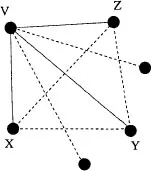
A Walk Through Combinatorics
An Introduction to Enumeration and Graph Theory
Miklós Bóna
- 492 Seiten
- English
- ePUB (handyfreundlich)
- Über iOS und Android verfügbar
A Walk Through Combinatorics
An Introduction to Enumeration and Graph Theory
Miklós Bóna
Über dieses Buch
This is a textbook for an introductory combinatorics course that can take up one or two semesters. An extensive list of problems, ranging from routine exercises to research questions, is included. In each section, there are also exercises that contain material not explicitly discussed in the preceding text, so as to provide instructors with extra choices if they want to shift the emphasis of their course.
Just as with the first edition, the new edition walks the reader through the classic parts of combinatorial enumeration and graph theory, while also discussing some recent progress in the area: on the one hand, providing material that will help students learn the basic techniques, and on the other hand, showing that some questions at the forefront of research are comprehensible and accessible for the talented and hard-working undergraduate. The basic topics discussed are: the twelvefold way, cycles in permutations, the formula of inclusion and exclusion, the notion of graphs and trees, matchings and Eulerian and Hamiltonian cycles. The selected advanced topics are: Ramsey theory, pattern avoidance, the probabilistic method, partially ordered sets, and algorithms and complexity.
As the goal of the book is to encourage students to learn more combinatorics, every effort has been made to provide them with a not only useful, but also enjoyable and engaging reading.
Contents:
- Basic Methods:
- Seven Is More Than Six. The Pigeon-Hole Principle
- One Step at a Time. The Method of Mathematical Induction
- Enumerative Combinatorics:
- There Are a Lot of Them. Elementary Counting Problems
- No Matter How You Slice It. The Binomial Theorem and Related Identities
- Divide and Conquer. Partitions
- Not So Vicious Cycles. Cycles in Permutations
- You Shall Not Overcount. The Sieve
- A Function is Worth Many Numbers. Generating Functions
- Graph Theory:
- Dots and Lines. The Origins of Graph Theory
- Staying Connected. Trees
- Finding a Good Match. Coloring and Matching
- Do Not Cross. Planar Graphs
- Horizons:
- Does It Clique? Ramsey Theory
- So Hard to Avoid. Subsequence Conditions on Permutations
- Who Knows What It Looks Like, but It Exists. The Probabilistic Method
- At Least Some Order. Partial Orders and Lattices
- The Sooner The Better. Combinatorial Algorithms
- Does Many Mean More Than One? Computational Complexity
Readership: Upper level undergraduates and graduate students in the field of combinatorics and graph theory.
Häufig gestellte Fragen
Information
13.1 Ramsey Theory for Finite Graphs
